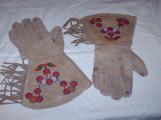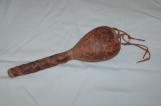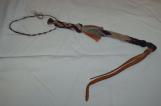1
Miistatosomitai - Mike Mountain HorseMike Mountain Horse "Miistatisomitai" was born in 1888, the son of the elder Mountain Horse, who fought with the Bloods against their enemies in the Last Great Battle at the Belly River in 1870. Born and reared among his tribe at a time when the band was adapting to Reserve life. At the age of six, he was sent to a Residential school on the Reserve operated by the Anglican Church.
With the outbreak of the First World War, Mike's brother Albert enlisted in the 23rd Alberta Rangers and was sent to France. Albert fought in the Second Battle of Ypres, and was gassed three times. With his lungs badly damaged, Alberta was invalided out of service, but he contracted tuberculosis and died in Montreal in 1915, while en route home. With his brother's death, Mike and another brother Joe enlisted in the Canadian Expeditionary Force to avenge their sibling. In France, Mike was wounded by an enemy's bayonet at the battle of Cambrai, and shipped to England to convalesce.
Upon discharge, Mike returned home and took employment as an interpreter with the Royal North West Mounted Police, helping to enforce the law among his people on the Reserve. In later years, he worked as a locomotive labourer in the Canadian Pacific Railroad shops in Lethbridge. In the 1920s, Mike became a journalist, and wrote many newspaper articles for the Lethbridge Herald. He also spent a great deal of time lecturing and visiting schools in order to share his people's culture and stories. Among his articles was the first published account of the Last Great Battle, which was based on his father's oral history of the conflict, and that of his uncle, Bull Shield.
In 1936, Mike collected many of his writings into a manuscript that was eventually called "My People The Bloods," a description of Kainai culture and history. The work remained unpublished until 1979 when released posthumously by the Glenbow-Alberta Institute in Calgary. Mike became a respected and educated man among the Kainai Nation, and upon his retirement in the late 1950s, he was elected to the Blood Tribal Council. Mike Mountain Horse passed away in 1964.
A small collection of hand-crafted items attributed to Mike Mountain Horse, a pair of gauntlets, a doll, a rattle and a riding quirt, has been donated to Fort Whoop-Up Interpretive Society by Cleve Hill, an area rancher and a long time friend of Mike Mountain Horse.
His legacy in cultural education carries on in the city of Lethbridge with the name of Mike Mountain Horse Elementary School.
2
Mike Mountain Horse - "Miistatosomitai"5 March 1959
Glenbow Archives, Calgary, Alberta
 Credits:
Credits:Gordon Armstrong Crighton
3
Gauntlets "Atsi'tsi" - of Mike Mountain Horse, "Miistatosomitai"Circa 1920s
Fort Whoop-Up National Historic Site
 Credits:
Credits:Gord Tolton
4
Rattle "Awanaan" - of Mike Mountain Horse, "Miistatosomitai"1900
Fort Whoop-Up National Historic Site
 Credits:
Credits:Gord Tolton
5
Riding Quirt - "Atsi'tsi" - of Mike Mountain Horse (Miistatosomitai)Circa 1890
Fort Whoop-Up National Historic Site
 Credits:
Credits:Gord Tolton
6
Female Doll "Atapiim" (Mike Mountain Horse)Circa 1930
Fort Whoop-Up National Historic Site
 Credits:
Credits:Gord Tolton